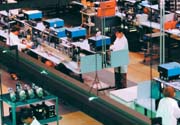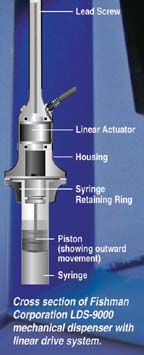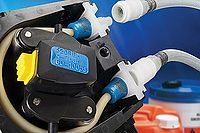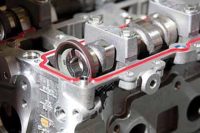
Air-Powered Dispensing
Pneumatic dispensers, or time/pressure pumps, are basic in design. Simply, they consist of a piston and a syringe and a blast of pulsed air from a compressor. The air is pulsed through a tube, and the pulses of air are applied to the chamber of air behind the piston for varying lengths of time. The piston, in turn, is propelled against the material, which is then thrust down the barrel of the syringe and expelled through a needle or tip. With a system of this type, you need to manage both the column of air behind the piston (the "pneumatic" portion of the dispense) and the column of fluid (the "fluidic" portion of the dispense) in front of it. Basically, you start with a short column of air and a long column of fluid and end with a long column of air and a short column of fluid. There are actually two dispenses taking place, and there are two distinctly different sets of motion occurring, the fluidic and the pneumatic.Pneumatic Problems
The volume of material dispensed depends on a combination of the viscosity of the material, actual air pressure supplied and amount of time the pressure is applied to the chamber of air behind the piston. On the plus side, this type of pump is relatively inexpensive.The air supply can be a problem in the pneumatic portion of benchtop dispensing. The simple act of supplying air is, in fact, not so simple.
Installing a new workstation, or simply moving a workstation to a different location, can be an expensive and time-consuming project. The work floor and hoses may need to be reconfigured, with consideration given to maintaining the safety and efficiency of the plant.
The strength and variety of air, once finally installed, can change from day to day, even hour to hour. Pneumatic supply lines within a given facility can routinely experience pressure drops along the line and can cause downtime on production lines for simple maintenance routines that may have been overlooked.
The air itself can often contain varying amounts of moisture. This can be a problem to some adhesives, and disastrous to others that may cure with moisture. When pulsed air from a line that is contaminated with water is blasted against the piston in a syringe, moisture can be introduced into the syringe, forced around the sides of the piston and into the material.
While the piston is slapping the material forward, the chamber of air in back of the piston is changing in volume. This will require a change in the amount of air required to move the piston forward consistently to deliver the same size shot as the previous deposit. Since this cannot be done efficiently, there is tremendous variability in the shot size.
While most time/pressure pumps incorporate a vacuum to "draw back" the material and prevent dripping from the tip after dispensing, the amount of vacuum - and hence the draw back - cannot be pre-set because the chamber of air in back of the piston that needs to be sucked back is constantly changing. This constant change can be somewhat compensated for by so-called "computer-learned functions" that reportedly correct this flaw, but the obvious truth is that each material is different, and the "computer-controlled" functions can merely compensate briefly until the chamber and the materials have altered the volume of air sufficiently to require more adjustment - also known as downtime.
Fluidic Problems
We have identified the problems with the chamber of air behind the piston, but we must remember that as the material in the syringe is expelled there are a number of changes occurring inside the chamber that hold the material, as well. Depending on the properties of the material, the pneumatic dispenser can aggravate a number of difficult problems in the fluidic process.With many filled materials, such as solder paste (the most common material in this category), pulsed air exacerbates the control problem by changing the homogeneity of the material. Components in adhesive mixes begin to separate out, and suspended particles can actually become compressed along the inner walls of the syringe. This is commonly referred to as "tunneling." As a result, variations in viscosity occur within the mix, thereby affecting flow behavior. The hidden cost in this phenomenon is the rework caused by inexact mix of material supplied and the wasteful practice of filling syringes half full. This is not necessary if the material is dispensed smoothly, as with a mechanical piston, and the tunneling effect is nearly eliminated.
With other materials, especially those that are heat activated, the pulsed air of a pneumatic dispenser stresses the material, and the turbulence created by the blasts of air heats the adhesive in the syringe, causing the viscosity to change faster than is necessary. This, in turn, affects the amount of adhesive being dispensed, and precise control is difficult to achieve. With single-component materials, the viscosity decreases with the heat.
With premixed and frozen syringes, on the other hand, the elevation in temperature actually begins to cure the adhesive, increasing the viscosity and ultimately making it impossible to dispense, even with the air pressure "cranked up." The operator is tempted to crank up the air pressure to dispense a thicker material, causing a vicious cycle of super heating the material. In the absence of this super heating, many users report a long extension of the work life of two-part epoxies. This becomes important for a number of reasons, which will be covered in the conclusion.
Thixotropic materials can be an especially difficult problem in that the viscosity of the material can change significantly due to the pulsing air and then change again while the fluid is at rest.
Operator Problems
Because of problems with control, technicians tend to "over" or "under" dispense adhesives. Over-dispensing wastes material, often makes stenciling of encapsulated components impossible, and can cause parts to be rejected during inspection. Under-dispensing can lead to components falling off or shifting position before or during reflow. Again, the result is rejection with possible rework.Either over-dispensing or under-dispensing can occur as the fluid becomes lower in the syringe. There is also less pressure against the piston at this time, and there is a danger that the dispensed dot or encapsulant may be undersized. In such a circumstance, the operator may then attempt to overcompensate for the lower pressure by increasing the pressure and the amount dispensed. Once again, this leads to the vicious cycle of compounding error and can be recreated by the "automatic" adjustments made by computerized controllers, as well.
Technicians using pulsed-air dispensers attempt to overcome control problems by using the smallest possible needle size for the requirement. As a result, the material is unnecessarily stressed, instead of being in a relaxed state where it can flow freely and smoothly. Stressing the material, as mentioned, causes changes in viscosity due to heating of the adhesive because of friction.
In addition to the problems mentioned above, the attention of the operator is severely divided between adjusting and readjusting the controls of the dispenser and the concentration necessary on deposit placement. This inattention can cause the operator to over-dispense. The resultant rework can slow throughput and increase production costs substantially.

The Mechanical-Dispensing Mechanism
The mechanical dispenser differs greatly from pneumatic systems. A cross-section illustration of the Fishman mechanical dispense gun is shown in the figure. The dispenser employs a linear actuator and a mechanical lead screw, which lowers or retracts an engageable mechanical piston.On command from a microprocessor control unit, the piston will push the material through the syringe and out the luer-lock dispense tip, which is available in a wide range of lengths, gauges and materials. An interference fit between the piston and syringe ensures against leakage of material and loss of pressure while increasing the accuracy of the pullback on the material.
A mechanical piston (showing outward movement in the figure) with a linear, actuator-driven mechanical lead screw moves the piston out on command from a microprocessor control unit. The material is pushed smoothly through the syringe and out the tip. A programmable drawback of the piston prevents material drip.
The screw travels along its axis, which is what makes this dispenser different from all others. The linear actuator moves the piston in the syringe by rotating a nut between electrically charged poles. The lead screw threads through the nut; the dispensing housing captures the top of the screw and prevents the screw from rotating. When actuated, the nut steps from one magnetic pole to the other, causing the screw and piston to move outward without twisting.
The lead screw and piston represent an enormous improvement over pneumatic systems, pinch valves and auger mechanisms, as well. In addition to the improved repeatability over pneumatic dispensers, the mechanical dispenser can deliver material without crushing the adhesive or paste, a possibility that exists with augers and pinch valves that can result in unwanted changes in the properties of the material.

The Control Unit
The control unit is a microprocessor that guarantees precise controls over volume output, based on the prescribed dispense rate and the known inside diameter of the specially designed syringe. The control unit automatically calculates the distance the piston must travel forward and backward for the correct shot size. The operator only needs to calibrate the system at the beginning of the process. Once calibrated, the system delivers the shots volumetrically, which means that even if the viscosity changes, the shot size stays relatively unaffected. The microprocessor will even track the amount of adhesive in the syringe so that an incomplete shot at the end will not be fired.To prevent dripping of material after a deposit, the system can be programmed to automatically draw the piston back, causing the material to recede slightly within the tip. The microprocessor calculates the distance traveled forward and then back, so that on the next dispense cycle the correct volume is dispensed. When potting or beading with a compressible fluid, a drawback delay can be programmed in at the end of the forward motion of the piston, before the drawback, to ensure complete dispensing.
With mechanical dispensing, the proper needle size can be used for the material and the application, because control is not a problem. As a result, the adhesive is in a relaxed state as it is dispensed. Material mixes remain uniform with less chance of curing in the syringe due to friction-induced heating and, because there is no air driving the piston, there can be no infusion of moisture or other contaminants in the material.
The Ultimate Solder-Paste Dispenser
Because of the mechanical system's ability to dispense materials smoothly, the phenomenon of "tunneling" is almost entirely eliminated. The mechanical piston is so smooth in its shot cycle that the material is not subjected to turbulence as noted above. In addition, the interference fit of the mechanical stopper against the walls of the syringe, plastic on plastic, allow an even "push" of the material that can not be matched for ease of use, repeatability and practicality. When the double-wiping stopper has emptied the syringe, both piston and syringe are disposable. There is no need to clean a metal piston or chamber, and there are no pneumatic components to complicate the dispensing of materials.Conclusion
With the continuing trend toward smaller components and pitches, applicators are turning to mechanical dispensers because of their ability to deliver the required repeatability and accuracy, shot for shot, through the life of the syringe.Material conservation is also a by-product of the accuracy of the mechanical system. Because the deposits are consistent in size, material usage can be accurately gauged and controlled. The half-full syringe of solder paste can be filled due to the absence of tunneling. Field placements show that just a few machines in a solder-paste application will cut costs dramatically.
When a premixed/frozen material is used, it is not unusual for costs to improve even more dramatically with mechanical dispensing. In addition to greater accuracy and reduced amounts of material needed, users of mechanical systems are often able to extend the work life of the material they are using. Because of the expensive nature of using a premixed/frozen material, the epoxy itself can be packaged in a larger syringe, sometimes reducing spending by as much as one half.
With a universal power supply as standard equipment, the mechanical system can be dialed in and shipped anywhere in the world to repeatably dispense the amount prescribed by the engineer. There is no variation in air pressure or concern about maintenance to consider. Because the controls are microprocessors, there are built-in and easy-to-use lockouts at both operator and supervisor levels to prevent tampering.
Mechanical dispensing is a technology embraced by Fortune 500 companies and small manufacturing shops alike, and deployed worldwide. This positive-displacement, benchtop dispenser overcomes the limitations of pneumatics to provide highly accurate, repeatable deposits. The remarkably affordable combination of proprietary dispensing gun, microprocessor-control unit, and inexpensive plastic syringes and pistons results in a level of performance previously unobtainable. It is now possible to have true positive displacement, on the benchtop, with the ease of use, economic and engineering advantages of a syringe-based system.
For more information about dispensing, call (800) 433-2115 or visit www.fishmancorp.com.

